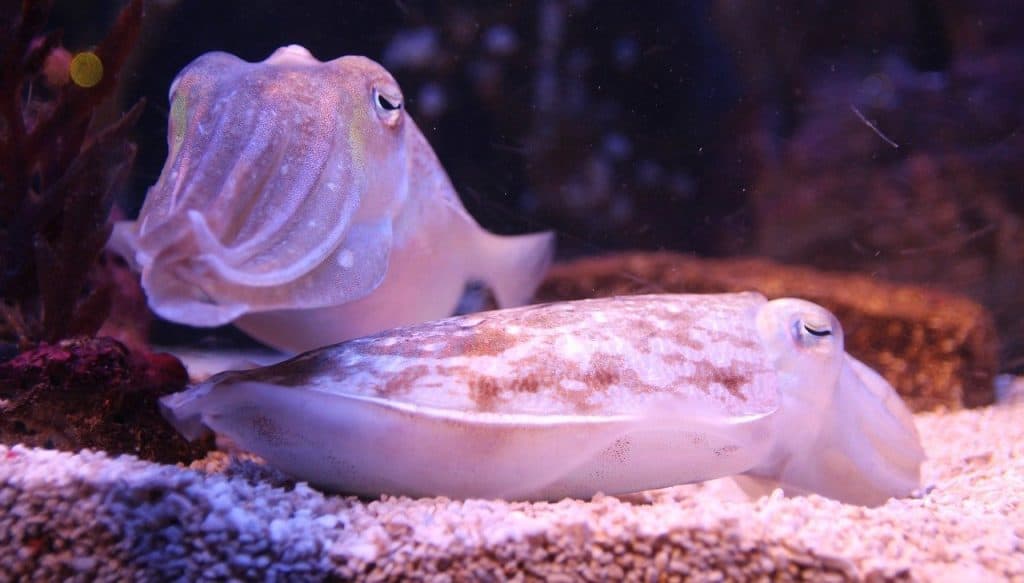Despite the name, it isn’t generally a fish by any means, Is any of a few marine cephalopods. It identifies with Octopus and squid. It has described by a thick calcified shell called squid bone. Around 100 types of Cuttlefish are in the scope of 2.5 to 90 cm (1 to 35 inches) and have level bodies encompassed by a couple of restricted blades.
All species have eight arms and two longer appendages to get prey and be removed into two pockets. The attractions cup has situated on the peninsula toward the receiving wire’s finish and the augmentation cushion.
Table of Contents
• What Do Cuttlefish Eat?
Cuttlefish are great hunters. They can get huge, quick-moving prey, for example, fish and shellfish like crabs, shrimps, and prawns.
• How Would They Feed?
Cuttlefish feed by utilizing their extendable arms to get prey as it moves past. They also have a well-honed snout (like a parrot’s bill) taken cover behind its appendages, which empowers Cuttlefish to benefit from hard-shelled creatures, such as crabs. The chomp presents a poison to immobilize any problematic prey rapidly.
Yet, there is a whole other world to them than meets the eye. Here are seventeen unique realities about Cuttlefish:
1. Cuttlebone
There is a long bone in the cuttlefish body, called a cuttlebone, to control brightness. The cuttlebone is not a real bone but an inner shell made of aragonite. Aragonite is a type of calcium carbonate with a grid-like structure.
Depending on the water part’s housing position, several housing chambers fill the gas or water. For example, there is little chance that the Cuttlefish needs to sink, which will add more water, and gas will inject into the cavity of the Cuttlefish. Interestingly, if the Cuttlefish needs to rise, it adds more gas than water.
Cuttlefish are sold in pet stores to enhance individual organisms, including poultry, because they contain a lot of calcium.
2. Where Cuttlefish Found
Cuttlefish can be discovered everywhere in the world in tropical and mild seas aside from the Americas. It has felt that Cuttlefish never made it to the Americas because the North Atlantic Ocean turned out to be excessively cold and profound.
Many jumps and snorkel administrators in the Caribbean tell their visitors they see Cuttlefish. However, they are Caribbean reef squid, which intently takes after Cuttlefish when they swim.
3. How Cattle Fish Grow
Fly forward!!! To develop quickly, the Cuttlefish uses its guide to expel the water in the mantle depression. They also have a balance surrounding the entire housing (main body), which use for control, adjustment, and further slow development.
4. Hatch From The Eggs
The eyes of the Cuttlefish are fully develop before they hatch from the eggs. They can even change color in response to external stimuli! It has believed that the small Cuttlefish started hunting prey while still in their eggs, tracking small fish and crustaceans’ activities, and preferring the game they saw during this time.
5. Hearts Of Cuttlefish
The Cuttlefish has three hearts and blue-green blood. One heart represents the whole body, and the other heart represents each group of cheeks. Blood is blue-green because it carries copper-containing proteins in the blood instead of iron proteins.
6. Chameleons Of The Sea
Cuttlefish are called “chameleons of the ocean” because of their continuous development of shadows. Although they are entirely visually challenged, they can still do it. They can even change the color tone effectively to harmonize environmental factors in an utterly dim environment.
Some animal categories use cumbersome designs to separate their charts, while others mix their environmental factors. That has done entirely by cells called chromophores in the skin. Various types of cells can recognize yellow, red/orange, and dark/earth colors. These units use as autonomously or together to create multiple shades and examples.
7. Mating Season Of Cuttlefishes
During the mating season, the male Cuttlefish changes tone to draw in an accomplice. There is even a video where there is a male cuttlefish. A big part of its body shows coquettish manners to females, while the other half shows forceful tones to oppose guys.
That is not kidding about performing various tasks! Some male creatures have found a superior method to discover a mate utilizing shading changes. These guys change their skin tone to speak to females, initiate guys to have a misguided feeling that all is well and good, and afterward rapidly mate with females behind them. That is the purported “tennis shoe man.
8. Sepia Color
Sepia ink is a mainstream ink shading got from Cuttlefish. Like the Octopus, the Cuttlefish has an ink sac that can empty ink of the ink sac when at severe risk or befuddles the foe. Used this ink to utilize for shade sepia, yet now they use artificial colors.
9. Beautiful Eyes Of Cuttlefish
Cuttlefish are particularly strong, and their strange and superb eyes enable them to spot suitable prey and start chasing them when they are bringing out. These mollusks’ eyes are large, light red in the shadow, and there are apparent w-shaped students. Cuttlefish have eyes everywhere from birth.
Their eyes plan encourages them to see clearly through the dissipated light found in the sea to chase their prey. Cuttlefish are partially blind, but they can see the contrast of light produced by polarization. Despite the visual challenges, these mollusks still have fantastic eyesight and can quickly move their entire focus to help them return items to zero.
They use this ability to focus quickly to help them distinguish colors. Since the optic nerve is behind the retina, they have no fragile side. Cuttlefish are partially blind, but they can see the contrast of light produced by polarization.
These mollusks will move the entire focus of their eyes to obtain a precise image. Indeed, even before the idea, the Cuttlefish can use its eyes to find suitable prey to start chasing when it hatches.
10. About Muscles
The dazzling Cuttlefish is insane. Their muscle tissue contains a very uncommon and incredible poison that researchers have not wholly perceived, which is why they show such astounding shadings. They presently don’t have to avoid hunters, so they are the base occupants. Utilize the two most giant arms as “front legs” and change their outer cover’s surface to make two “back legs”.
11. Cuttlefish Can Imitate The Shape And Texture Of Objects
Around It is work to keep away from hunters. Their nearby family member, Octopus, can do likewise. Cuttlefish accomplish this surface change by broadening or withdrawing little projections called areolas situated on their bodies to all the more likely match the sand, rough shakes, or different surfaces they cover-up.
12. Eat Less Lunch When They Are Expecting A Big Dinner
When they realize that prawns-their number one food-will be available later in the day, the Cuttlefish will eat fewer crabs prior. Scientists express that this capacity to settle on choices dependent on future desires shows that Cuttlefish have complex intellectual capabilities.
It is astounding to perceive how rapidly Cuttlefish adjust to their eating conduct in only a couple of days, and they know whether they have shrimp around evening time. That is confounded conduct, and simply because their fish has muddled conduct is conceivable.
The cerebrum”, Pauline Billard (Pauline Billard), a Ph.D. understudy in the Department of Psychology at the University of Cambridge, is additionally the lead creator of the investigation distributed in Biology Letters.
13. Cuttlefish Are Intelligent
An examination distributed in the Royal Society Proceedings found that one-month-old Cuttlefish can without much of a stretch recognize the contrast between a crate of four shrimps and a container of five shrimps.
Interestingly, a one-year-old child can decide the distinction somewhere in the range of one and two heaps and two and three heaps, yet can’t surpass this distinction. When there was more shrimp in the container, the squid took more time to choose which box to eat. The scientists utilized this to sign that the squid was checking the shrimp before settling on a choice.
14. Cuttlefish Are Very Impressive
Cuttlefish’s vision is truly noteworthy. Thatitven can thoroughly observe the substance behind it. As indicated by PBS, “It tends to be seen well in low light, and it can likewise identify energized morning, consequently upgrading the difference.
When we people reshape the focal point to zero in on a particular item, the Cuttlefish reshape the whole eye. Move its focal point. What’s more, the Cuttlefish’s eyes are in huge extents to its body, which may build the amplification of the picture on the retina, and the novel “W”- formed pupil helps control the force of light entering the eye.
15. Blood Of Cuttlefish
Cuttlefish’s blood is a strange blue-green color because it uses the copper-containing protein hemocyanin to transport oxygen instead of the red iron-containing protein hemoglobin found in invertebrates. It’s like arthropod blood.
Hemoglobin cannot transport oxygen as well as hemoglobin. Three separate “hearts have siphoned the blood”. Two of them have used to siphon blood into the Cuttlefish’s g (each g has a heart), and the third has used to siphon blood from the rest of the body.
16. Species Of Cuttlefish
There are more than 100 types of Cuttlefish. The size of these creatures has changed from a few small monsters to a few feet long. Monster cuttlefish is the largest species of Cuttlefish, which can grow up to 50 cm in length and weigh more than 10 kg.
17. Communication Of Cuttlefish
If the male Cuttlefish can talk, this may be his first line. Although Cuttlefish do not use sound to transmit sound, males have initial lines, which may mean that Cuttlefish and Cuttlefish extend to a greater extent.
They spread information in beautiful spots, spots, and tone. Squid adds several swimming postures for this particular visual correspondence and provides ten arm postures. In addition to Octopus, Cuttlefish and squid also belong to the Cephalopoda category.
Mollusks include snails and mollusks. The spiritual monster in the mollusk world, cephalopods, use their limbs to control objects, fly around with flies, eat with their mouths and noses, and see things with the naked eye as confusing as ourselves.
Summarizing
Cuttlefish generally live in shallow reefs, but they can also live in straits and deeper waters up to 650 feet (about 200 m). They have widely spread, and more than 120 outstanding cuttlefish are there. New species are persistently being distinguished, and it has essential to remember that no cuttlefish species harm so far, and expanded fishing may pose a danger.
Cuttlefish are used by humans as food and a source of ink, while the dietary nutrition of Cuttlefish allows calcium to limit flying creatures. Octopus, squid, Cuttlefish, and nautilus are identifiable media. Cuttlefish has sometimes kept as pets, partly because of their short lifespan. Cuttlefish feed on food in the Mediterranean, East Asia, the English Channel, and other places. In East Asia, dried, destroyed Cuttlefish has known to be cannibalized.

I am a primary writer, mom, and long-time cat parent. My two Russian Blues are the queens of my house. Cats are the most loved pet all over the world due to their cuddly gestures and cute looks. I always felt my soul has a deeper bond with animals, especially cats.
My work is to guide pet owners about their frequent queries about their beloved one pet. I have spent 10 years of my life working with hundreds of animal species. This passion for animal care and love gives me the courage to spread my words worldwide. My writings will help you to decide about the food, housing, and training of your pet.

